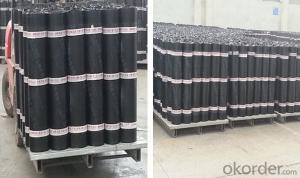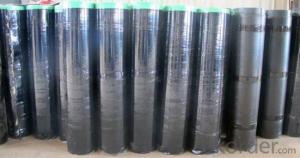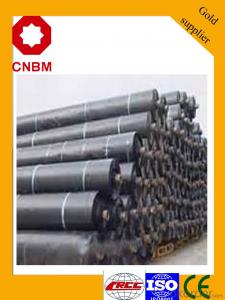SBS-Modified Bitumen Waterproof Membrane with Polyester Fiber and PE Film Type II,4mm
- Loading Port:
- Tianjin
- Payment Terms:
- TT OR LC
- Min Order Qty:
- 1000 m²
- Supply Capability:
- 500000 m²/month
OKorder Service Pledge
OKorder Financial Service
You Might Also Like
SBS-PYPE is a waterproofing modified bitumen base sheet consisting of styrene-butadiene-styrene (SBS) modified asphalt reinforced with polyester fiber covering with polyethylene surfacing. There have two kinds of thickness: 3 mm, 4 mm。
We have two kinds of type in our company。They are I type and II type。They have differentt kinds of low temperature flexibility。
This type is 4mm thickness,type II。
If you want to know more about us,call the salesman of CNBM International Corporation (CNBM International) 。
CNBM INTERNATIONAL CORPORATION
Address:17th Floor, NO.4 Building, Zhuyu Business Center, Shouti South Road,Haidian District, Beijing,China
Post Code:100048
Tel:(86-10)68796888
Fax:(86-10) 68796668
Email:marketing@okorder.com, hr@okorder.com
- Q: Are waterproofing membranes suitable for below-grade applications?
- Yes, waterproofing membranes are suitable for below-grade applications. Waterproofing membranes are specifically designed to prevent the infiltration of water into below-grade structures such as basements, foundations, and retaining walls. These membranes are made from durable materials that can withstand the pressure of soil and water, ensuring long-term protection against leaks and water damage. They are typically installed on the exterior side of the below-grade structure to create a barrier that prevents water from seeping through the walls or floors. Additionally, waterproofing membranes are flexible and can accommodate structural movements, ensuring their effectiveness even in challenging below-grade environments. Overall, waterproofing membranes are a reliable and effective solution for protecting below-grade structures from water intrusion.
- Q: Can a waterproofing membrane be used on retaining walls?
- Using a waterproofing membrane on retaining walls is possible. Retaining walls often face moisture and hydrostatic pressure, which can result in water infiltration and structural decay. By applying a waterproofing membrane to the retaining wall, water penetration can be prevented, shielding the wall from moisture-related harm and extending its lifespan. The membrane acts as a barrier, stopping water from seeping into the wall and causing problems like efflorescence, cracks, or erosion. It is crucial to select a waterproofing membrane that is designed specifically for below-grade applications and can withstand the pressure exerted by the soil being retained. Moreover, proper installation techniques and suitable drainage systems should be taken into account to ensure the effectiveness of the waterproofing membrane on retaining walls.
- Q: Can a waterproofing membrane be used for a swimming pool deck?
- Yes, a waterproofing membrane can be used for a swimming pool deck. Waterproofing membranes are designed to provide a barrier against water infiltration, which makes them suitable for protecting the pool deck from water damage and ensuring its longevity.
- Q: Can a waterproofing membrane be used on PVC roofs?
- Yes, a waterproofing membrane can be used on PVC roofs. PVC (polyvinyl chloride) roofs are commonly used in commercial and residential buildings due to their durability and resistance to weathering. However, like any roofing material, PVC roofs can develop leaks or cracks over time. Applying a waterproofing membrane can help protect the roof from water infiltration and extend its lifespan. Waterproofing membranes, such as EPDM (ethylene propylene diene terpolymer) or TPO (thermoplastic olefin), are flexible and can adhere to the PVC surface, creating a seamless and watertight barrier. It is important to ensure that the waterproofing membrane is compatible with PVC roofs and follow the manufacturer's instructions for proper installation. Regular maintenance and inspections are also recommended to identify and address any potential issues before they escalate.
- Q: SBS Shale Waterproof Coil
- Features: low temperature flexibility is good, to -25 ℃ does not crack; high heat resistance, 90 ℃ does not flow. Good extension performance, long service life, simple construction, small pollution and so on. Products for Ⅰ, Ⅱ level building waterproofing works, especially for low temperature cold areas and structural deformation of the frequent building waterproofing works.
- Q: Can waterproofing membranes be used on bridge decks?
- Bridge decks can benefit greatly from the application of waterproofing membranes. Due to the constant exposure to harsh weather conditions like rain, snow, and freeze-thaw cycles, the concrete and steel reinforcement of bridge decks can deteriorate. Waterproofing membranes are specifically designed to counter water infiltration and safeguard the bridge deck against damage caused by moisture. Typically composed of flexible materials like bitumen, PVC, or EPDM rubber, these membranes are directly applied to the surface of the bridge deck. Acting as a barrier, they prevent water from seeping into the concrete and causing corrosion of the reinforcement. They also help minimize crack formation and extend the lifespan of the bridge deck. Furthermore, the effectiveness and durability of waterproofing membranes can be enhanced by combining them with other protective coatings or systems. All in all, the utilization of waterproofing membranes on bridge decks is a widely employed and successful approach to ensure the long-term integrity and functionality of the structure.
- Q: How does a waterproofing membrane handle hydrostatic pressure?
- A waterproofing membrane handles hydrostatic pressure by acting as a barrier between water and the structure it is applied to. When exposed to hydrostatic pressure, which is the pressure exerted by standing or moving water, the membrane forms a continuous seal that prevents water from penetrating into the structure. The membrane is designed to be impermeable, meaning that it does not allow water molecules to pass through it. It is typically made of materials such as rubber, PVC, or bitumen that have high resistance to water penetration. These materials are also flexible, allowing the membrane to conform to the contours of the surface it is applied to and provide a tight seal. When hydrostatic pressure is applied to the membrane, it resists the force and prevents water from infiltrating the structure. The membrane's resistance to water pressure is a result of its thickness, strength, and the quality of its installation. Thicker membranes are generally more resistant to hydrostatic pressure, while a properly installed membrane with no gaps, voids, or overlaps enhances its effectiveness in handling water pressure. In addition to providing a barrier against water penetration, some waterproofing membranes are also designed to accommodate movement caused by hydrostatic pressure. They can stretch or elongate to accommodate the expansion and contraction of the structure due to varying water levels or other external forces. This flexibility helps the membrane maintain its integrity and prevent water from seeping through. Overall, a waterproofing membrane effectively handles hydrostatic pressure by providing a continuous, impermeable barrier that resists the force of standing or moving water and prevents it from infiltrating the structure. Its ability to withstand water pressure is dependent on its thickness, strength, installation quality, and flexibility to accommodate movement.
- Q: Can a waterproofing membrane be used on TPO roofs?
- Yes, a waterproofing membrane can be used on TPO roofs. TPO (thermoplastic olefin) is a popular roofing material that is known for its durability and energy efficiency. However, like any roofing material, TPO roofs can still be susceptible to leaks and water damage over time. To enhance the waterproofing capabilities of a TPO roof, a waterproofing membrane can be applied. A waterproofing membrane is a thin layer of material that is designed to prevent water infiltration. It is typically made from synthetic materials such as modified bitumen, EPDM, or PVC. These membranes are highly effective in creating a barrier against water, protecting the underlying roof structure from leaks and potential damage. When applying a waterproofing membrane on a TPO roof, it is important to ensure compatibility between the materials. The membrane should be specifically designed for use on TPO roofs and should be approved by the manufacturer of the TPO roofing system. This will ensure that the membrane is compatible with the TPO material and will not cause any adverse reactions or void any warranties. The installation of a waterproofing membrane on a TPO roof typically involves cleaning and preparing the surface, applying a primer if necessary, and then adhering the membrane to the roof using an appropriate adhesive or heat welding method. Once installed, the membrane acts as an extra layer of protection, preventing water from penetrating the TPO roof system and causing damage. In conclusion, a waterproofing membrane can be used on TPO roofs to enhance their waterproofing capabilities and protect against leaks. However, it is important to choose a membrane that is specifically designed for use on TPO roofs and is approved by the manufacturer of the TPO roofing system. Proper installation and regular maintenance will ensure the longevity and effectiveness of the waterproofing membrane on a TPO roof.
- Q: Can a waterproofing membrane be used for swimming pool coping?
- No, a waterproofing membrane is not typically used for swimming pool coping. Coping refers to the materials used to cap the edge of a swimming pool, such as tiles or stones. While a waterproofing membrane may be used to seal and protect the pool shell, it is not designed to serve as a coping material.
- Q: Can a waterproofing membrane be used for elevator pits?
- One can utilize a waterproofing membrane for elevator pits. Elevator pits, typically situated at the lowest level of a building, are susceptible to water infiltration, particularly in regions with high groundwater levels or heavy precipitation. By implementing a waterproofing membrane in the elevator pit, the ingress of water can be prevented, thereby averting harm to the elevator machinery and preserving the pit's structural integrity. Waterproofing membranes are engineered to establish a barrier against water penetration and can be employed on both the walls and floor of the elevator pit to ensure optimal protection. It is imperative to select a top-notch waterproofing membrane that is specifically intended for below-grade applications and can endure continual exposure to moisture. Moreover, the proper installation by skilled professionals is vital to guarantee the efficiency and longevity of the waterproofing system.
Send your message to us
SBS-Modified Bitumen Waterproof Membrane with Polyester Fiber and PE Film Type II,4mm
- Loading Port:
- Tianjin
- Payment Terms:
- TT OR LC
- Min Order Qty:
- 1000 m²
- Supply Capability:
- 500000 m²/month
OKorder Service Pledge
OKorder Financial Service
Similar products
Hot products
Hot Searches
Related keywords
























